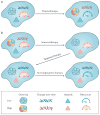Classifying the evolutionary and ecological features of neoplasms
- PMID: 28912577
- PMCID: PMC5811185
- DOI: 10.1038/nrc.2017.69
Classifying the evolutionary and ecological features of neoplasms
Abstract
Neoplasms change over time through a process of cell-level evolution, driven by genetic and epigenetic alterations. However, the ecology of the microenvironment of a neoplastic cell determines which changes provide adaptive benefits. There is widespread recognition of the importance of these evolutionary and ecological processes in cancer, but to date, no system has been proposed for drawing clinically relevant distinctions between how different tumours are evolving. On the basis of a consensus conference of experts in the fields of cancer evolution and cancer ecology, we propose a framework for classifying tumours that is based on four relevant components. These are the diversity of neoplastic cells (intratumoural heterogeneity) and changes over time in that diversity, which make up an evolutionary index (Evo-index), as well as the hazards to neoplastic cell survival and the resources available to neoplastic cells, which make up an ecological index (Eco-index). We review evidence demonstrating the importance of each of these factors and describe multiple methods that can be used to measure them. Development of this classification system holds promise for enabling clinicians to personalize optimal interventions based on the evolvability of the patient's tumour. The Evo- and Eco-indices provide a common lexicon for communicating about how neoplasms change in response to interventions, with potential implications for clinical trials, personalized medicine and basic cancer research.
Conflict of interest statement
The authors declare no competing interests.
Figures




Comment in
-
The benefits of speaking a common language.Nat Rev Cancer. 2017 Sep 25;17(10):571. doi: 10.1038/nrc.2017.91. Nat Rev Cancer. 2017. PMID: 28943639 No abstract available.
References
-
- Nowell PC. The clonal evolution of tumor cell populations. Science. 1976;194:23–28. This is the seminal paper laying out the evolutionary theory of cancer. - PubMed
-
- Mroz EA, et al. High intratumor genetic heterogeneity is related to worse outcome in patients with head and neck squamous cell carcinoma. Cancer. 2013 http://dx.doi.org/10.1002/cncr.28150. - DOI - PMC - PubMed
Publication types
MeSH terms
Substances
Grants and funding
- R35 CA197623/CA/NCI NIH HHS/United States
- R01 CA185138/CA/NCI NIH HHS/United States
- 105104/Z/14/Z/WT_/Wellcome Trust/United Kingdom
- 20466/CRUK_/Cancer Research UK/United Kingdom
- 17786/CRUK_/Cancer Research UK/United Kingdom
- FC001169/MRC_/Medical Research Council/United Kingdom
- MR/P014712/1/MRC_/Medical Research Council/United Kingdom
- U01 CA195469/CA/NCI NIH HHS/United States
- 617457/ERC_/European Research Council/International
- K99 CA201606/CA/NCI NIH HHS/United States
- 19310/CRUK_/Cancer Research UK/United Kingdom
- U54 CA193461/CA/NCI NIH HHS/United States
- R01 CA140657/CA/NCI NIH HHS/United States
- U54 CA163124/CA/NCI NIH HHS/United States
- P01 CA093900/CA/NCI NIH HHS/United States
- U01 CA143055/CA/NCI NIH HHS/United States
- 18377/CRUK_/Cancer Research UK/United Kingdom
- U54 CA193489/CA/NCI NIH HHS/United States
- U54 CA143803/CA/NCI NIH HHS/United States
- P01 CA091955/CA/NCI NIH HHS/United States
- FC001169/CRUK_/Cancer Research UK/United Kingdom
- R01 CA149566/CA/NCI NIH HHS/United States
- U01 CA151924/CA/NCI NIH HHS/United States
- U10 CA180857/CA/NCI NIH HHS/United States
- R21 CA196460/CA/NCI NIH HHS/United States
- R01 CA170595/CA/NCI NIH HHS/United States
- 21808/CRUK_/Cancer Research UK/United Kingdom
- T32 CA093245/CA/NCI NIH HHS/United States
- FC001169/WT_/Wellcome Trust/United Kingdom
LinkOut - more resources
Full Text Sources
Other Literature Sources

